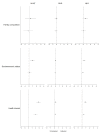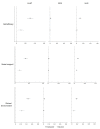Comparison of Health Literacy Assessment Tools among Beijing School-Aged Children
- PMID: 36010019
- PMCID: PMC9406777
- DOI: 10.3390/children9081128
Comparison of Health Literacy Assessment Tools among Beijing School-Aged Children
Abstract
Health literacy is a broad and multidimensional construct, making its measurement and conclusions inconsistent. This study aims to compare the patterning of health literacy using different assessment tools and examine their impact on children's developmental outcomes. A cross-sectional study was conducted with 650 students in Years 7-9 from four secondary schools in Beijing. Health literacy was measured by the eight-item health literacy assessment tool (HLAT, score range 0-37), the six-item Newest Vital Sign (NVS, score range 0-6), and the 16-item Health Literacy Survey (HLS, score range 0-16). Based on Manganello's health literacy framework, information on upstream factors (e.g., gender, ethnicity, socioeconomic status) and developmental outcomes (e.g., health-promoting behaviours, health service use, global health status) was collected. Overall, the average scores for health literacy were 26.34 ± 5.89, 3.64 ± 1.64, and 13.72 ± 2.94, respectively, for HLAT, NVS, and HLS. The distribution of health literacy varied by socio-demographics and individual characteristics except for gender, no matter which health literacy assessment tool was used. The magnitude of associations between health literacy, its upstream factors and developmental outcomes was greater when using three-domain instruments (HLAT and HLS) than using single-domain instruments (NVS). The approach to health literacy measurement will influence the conclusion. Using multidimensional assessment tools may better capture a child's health literacy and contribute to the maximum efficiency and effectiveness of school-based health literacy interventions.
Keywords: children; cross-sectional; health literacy measurement; inequities; secondary school.
Conflict of interest statement
The authors declare no conflict of interest.
Figures





Similar articles
-
Adolescent Health Literacy in Beijing and Melbourne: A Cross-Cultural Comparison.Int J Environ Res Public Health. 2020 Feb 14;17(4):1242. doi: 10.3390/ijerph17041242. Int J Environ Res Public Health. 2020. PMID: 32075168 Free PMC article.
-
Measuring functional, interactive and critical health literacy of Chinese secondary school students: reliable, valid and feasible?Glob Health Promot. 2018 Dec;25(4):6-14. doi: 10.1177/1757975918764109. Epub 2018 Apr 11. Glob Health Promot. 2018. PMID: 29638175
-
Health Literacy: An Interactive Outcome Among Secondary Students in Beijing.Health Lit Res Pract. 2021 Jan 11;5(1):e1-e14. doi: 10.3928/24748307-20201117-01. Health Lit Res Pract. 2021. PMID: 33433628 Free PMC article.
-
Quality of health literacy instruments used in children and adolescents: a systematic review.BMJ Open. 2018 Jun 14;8(6):e020080. doi: 10.1136/bmjopen-2017-020080. BMJ Open. 2018. PMID: 29903787 Free PMC article.
-
Validity, Reliability, and Feasibility of Physical Literacy Assessments Designed for School Children: A Systematic Review.Sports Med. 2023 Oct;53(10):1905-1929. doi: 10.1007/s40279-023-01867-4. Epub 2023 Jun 21. Sports Med. 2023. PMID: 37341907 Free PMC article.
Cited by
-
Promoting Child Health Equity through Health Literacy.Children (Basel). 2023 May 30;10(6):975. doi: 10.3390/children10060975. Children (Basel). 2023. PMID: 37371207 Free PMC article.
References
-
- Nutbeam D. Health literacy as a public health goal: A challenge for contemporary health education and communication strategies into the 21st century. Health Promot. Int. 2000;15:259–267. doi: 10.1093/heapro/15.3.259. - DOI
LinkOut - more resources
Full Text Sources

